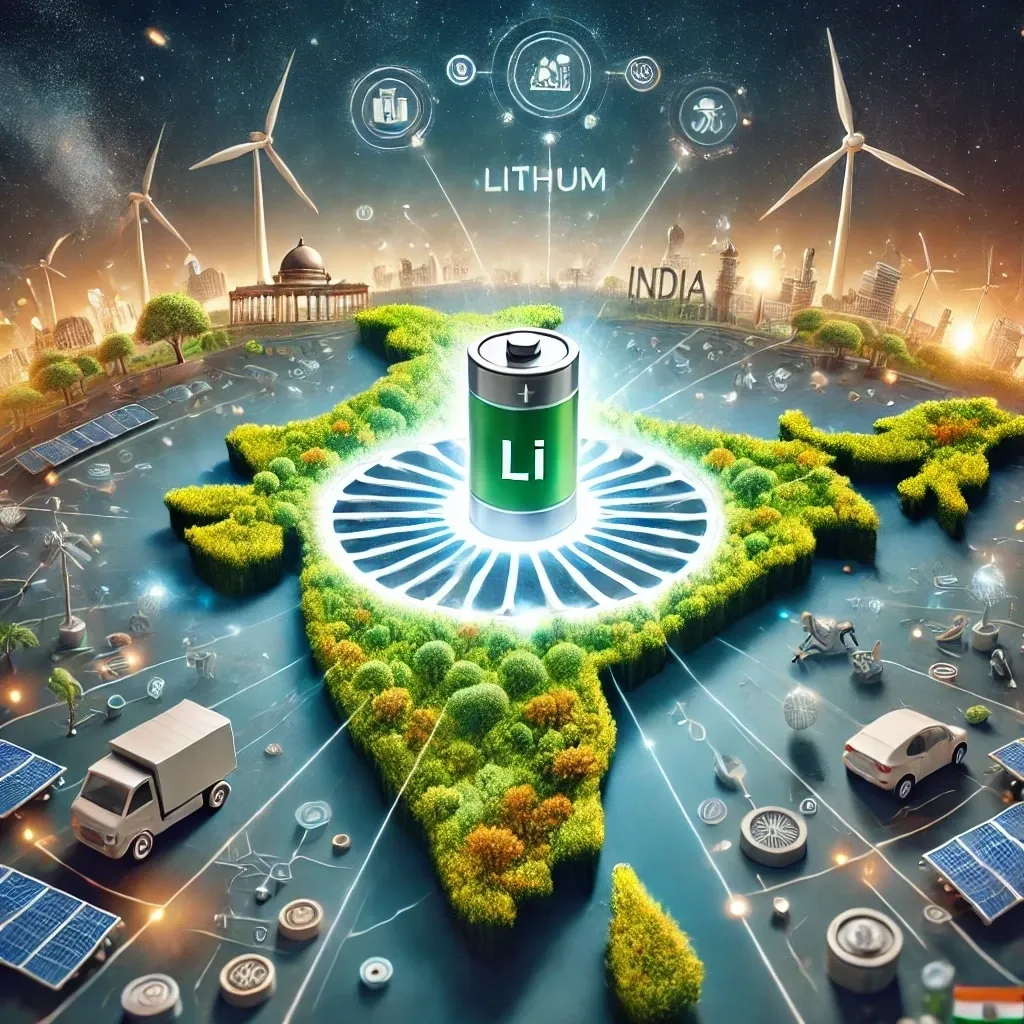Last year, the Government of India classified a total of 30 minerals as belonging to the category of “critical minerals”. As the world accelerates toward a decarbonised future, critical minerals have emerged as the new gold of global geopolitics, the lifeblood of clean energy technologies. Of all these minerals, lithium stands paramount, especially for India, which finds itself at a pivotal juncture in its transition to a sustainable economy. India’s journey toward achieving a “just transition”- a shift toward green energy without sidelining social and economic inclusivity – cannot be realised without securing a robust supply of lithium.
Lithium, often called the “white gold” of the energy revolution, is indispensable to the production of lithium-ion batteries, which power electric vehicles (EVs), renewable energy storage systems, and a range of consumer electronics. With India racing toward its goal of net-zero carbon emissions by 2070, the country must expand its reliance on renewable energy and EV adoption. The International Energy Agency (IEA) estimates that by 2040, the global demand for lithium will grow more than fivefold due to rising EV penetration and renewable energy storage requirements. For India, a country with ambitions to build a US $1 trillion green economy, lithium is by all accounts the linchpin.
India has outlined ambitious plans to shift toward renewable energy, with targets of achieving 500 GW of non-fossil fuel energy capacity by 2030. This transition is highly dependent on energy storage technologies to balance the intermittency of renewable sources like solar and wind. Lithium-ion batteries, which dominate the global battery market, are pivotal to this vision. Sans a secure supply of lithium, India’s renewable energy goals and its aspirations of becoming a major player in electric mobility will remain elusive.
India is heavily dependent on imports to meet its lithium requirements, a fact that has become more pronounced in recent years as demand continues to surge. Analysing the import data from 2019-20 to 2023-24 paints a revealing picture of India’s growing reliance on this critical mineral.
From 2019-20 to 2023-24, India’s lithium imports grew by over 60%, reflecting an upward trajectory that is likely to accelerate further in the coming years. However, the data also indicates a fluctuating pattern—after an initial dip in 2021-22, the import value surged again, reaching a peak in 2023-24 at US $33.41 million. This inconsistency in imports can be attributed to several factors: global supply chain disruptions, price volatility in the international market, and India’s still-developing domestic infrastructure for lithium battery production.
The volatility in India’s lithium imports, particularly the dip in 2021-22, can be explained by the global disruption caused by the COVID-19 pandemic. As a highly traded commodity, lithium was not immune to supply chain bottlenecks that led to price spikes and reduced availability. In addition, geopolitical tensions and trade restrictions – especially with countries like China, a dominant player in the lithium supply chain – have made it difficult for India to secure stable, affordable imports. As the demand for lithium intensifies globally, supply scarcity could push prices higher, further straining India’s ability to procure sufficient quantities.
The Indian government’s aggressive push for EV adoption through schemes like FAME II (Faster Adoption and Manufacturing of Hybrid and Electric Vehicles) and the National Electric Mobility Mission Plan has significantly spiked the demand for lithium. The rapid electrification of transportation is crucial for reducing the country’s carbon footprint, but it also amplifies India’s dependency on imported lithium. With projections suggesting that India’s EV market will grow at a compound annual growth rate (CAGR) of 44% from 2022 to 2027, the country’s reliance on lithium imports is only set to rise further.
Despite the growing demand, India remains largely deficient in domestic lithium resources. Although the Geological Survey of India (GSI) recently discovered lithium reserves in Jammu and Kashmir (J&K), the reserves are still in the exploration phase, and it will take years before they can be commercially exploited. Until then, India will remain reliant on imports, primarily from countries like Australia, Chile, Bolivia and Argentina – the latter trio being part of the global lithium triangle. The lack of domestic production capacity not only creates supply insecurity but also raises concerns about the long-term sustainability of the country’s lithium dependency.
India is not alone in its quest for lithium. Countries across the globe are racing to secure this critical mineral, leading to a geopolitical scramble that has reshaped international relations. Nations with abundant lithium reserves have become increasingly strategic partners, while countries like China have capitalised on their dominance in lithium refining and battery manufacturing to exert influence over global supply chains.
For India, this necessitates a multifaceted strategy. The government has already initiated efforts to secure lithium supplies by forming bilateral agreements with resource-rich nations. One such example is the India-Australia Critical Minerals Investment Partnership, which seeks to diversify India’s lithium sources and reduce its dependency on China.
At the same time, India must invest in building a robust domestic battery manufacturing ecosystem. The government’s Production-Linked Incentive (PLI) scheme for Advanced Chemistry Cell (ACC) battery storage is a step in the right direction, aimed at creating local capacities for the manufacturing of lithium-ion cells. However, for this to be effective, India will need to secure not just lithium, but other critical minerals like cobalt and nickel, which are also integral to battery technology.
As India moves forward, it is essential to consider the sustainability of its lithium consumption. Mining and refining lithium are resource-intensive processes that come with significant environmental costs. To mitigate this, India must embrace circular economy principles – focusing on recycling lithium-ion batteries and reducing the extraction of raw lithium. Currently, India recycles less than 5% of its lithium-ion batteries, but this figure must rise dramatically if the country is to secure a sustainable supply of the metal.
The establishment of a comprehensive battery recycling industry could create a secondary supply chain for lithium, reducing dependency on imports and lowering environmental impacts. By better R&D investment, India can also explore alternatives to lithium-ion technology, such as solid-state batteries, which promise higher energy densities and improved safety.
Lithium is undeniably the most critical mineral for India’s just transition. It lies at the heart of the country’s renewable energy and EV ambitions, and its secure supply will determine the success of India’s green transformation. However, India’s increasing reliance on imports, coupled with global supply chain challenges, demands the urgent need for a strategic response. To achieve a just transition, India must not only secure lithium but also develop domestic battery production and recycling capabilities, while navigating the geopolitical dynamics of the global lithium race.
As the adage goes, those who control the minerals control the future. For India, that future depends on how well it manages its lithium conundrum.

